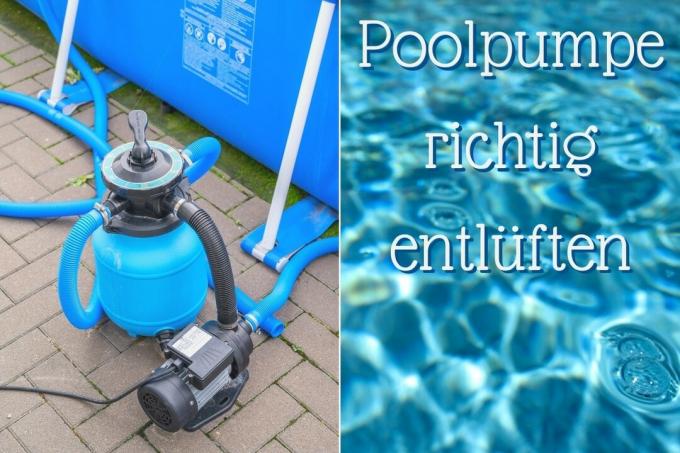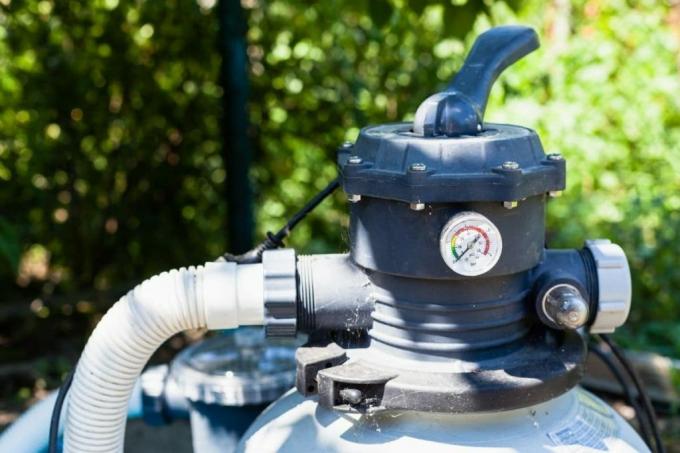
table of contents
- Venting: When is it necessary?
- Bleed after maintenance
- Vent the sand filter system: Instructions
- Prime the underwater pool pump
- frequently asked Questions
Air in the system is often the cause of a drop in the performance of the pool pump. This severely restricts the delivery and filter performance. If so, you need to prime the pool pump.
In a nutshell
- Air causes a drop in performance in the pool
- Air bubbles can be seen in the pump water
- Air is released through valves
Venting: When is it necessary?
When to prime a pool pump depends on a number of factors. You can recognize the need for venting either directly from the air bubbles within the components of the pump or from certain signs that appear in the pool, for example. Air collects in the pool pump when return water is drawn in. In the case of self-priming pool pumps that are installed above the water level, additional air enters the circuit as it is also sucked in. This problem can be identified by the following signs:
- poor filter performance
- muddy water
- weak pressure on the pool nozzles
If these points are recognizable over a longer period of time, you must expect air in the pump. To be completely on the safe side that you have to vent your sand filter system, check the pump. Air bubbles in the water indicate the unfavorable condition. You can find these in the following components of the pump:
- Hoses
- Pre-filter
- Sight glass

Note: Pool pumps that pump a large volume of water are particularly low-maintenance. With these, the air in the return water is not really a problem, unless the air bubbles predominate in the pool pump, so you have to vent them.
Bleed after maintenance
In addition to the points already mentioned, it is also advisable to vent your sand filter system when you have carried out maintenance measures. After this, air accumulation within the pump occurs more frequently if something is not done immediately to counteract it. It is essential that you bleed the pump in your pool after performing the following maintenance measures:
- Sand change
- Replacement and repair of individual components
- First operation after winter
- Filter cleaning
- Use of the pool vacuum via skimmer
Vent the sand filter system: Instructions
If you discover air bubbles in the pool pump, you should deflate them as soon as possible. So that there is no more air in the pump circuit at the end, you must proceed as precisely as possible with variants installed above the water surface. The following guide will help you:
- Switch off the pump
- Close the mount valve
- Unscrew the ventilation mechanisms (e.g. B. Vent screw)
- Let the air out completely
- Let the water run into the pump
- Set the mount valve to circulation
- Check the air in the hoses
- repeat if necessary
When bleeding, check the condition of the pool pump. Occasionally, air bubbles can enter the pump due to damaged components. In this case it is necessary to replace the damaged components, otherwise new air bubbles will keep getting into the pump.

Tip: Place a bucket under the hoses or valves when deflating, especially when storing the pump indoors. This will protect the floor from the pool water.
Prime the underwater pool pump
If your sand filter system is below the surface of the water, the effort involved in venting is significantly reduced. Since only a small amount of air is sucked in, you do not have to adjust anything on the pump. In this case, make use of the ventilation mechanisms of the sand filter system. To do this, all you have to do is unscrew the vent screw or the vent hose a little until you can hear air. Let the air escape until you can see water. The water indicates that there is no more air in the pump.
frequently asked Questions
No, if you are using a pool pump with cartridges or cartridges, venting is not necessary. The pumps do not suck in the water, which means that no air can get into the system. These are circulation pumps that must always be placed below the water level.
Air in the tubes is quite stubborn. To remove the air from these, you should never disassemble the hoses. They are shaken repeatedly one after the other while the ventilation wheel or valve is opened a little. Depending on the amount of air inside the hoses, you have to expect a lot of time of several minutes per hose.
Pumps with an automated mount valve attract return water in some situations, which can create negative pressure after a while. Vacuum ensures that the valve is opened. This allows air to get into the pool pump. When using a fully automatic rewind valve, it is important that it is installed optimally so that this problem does not arise.
